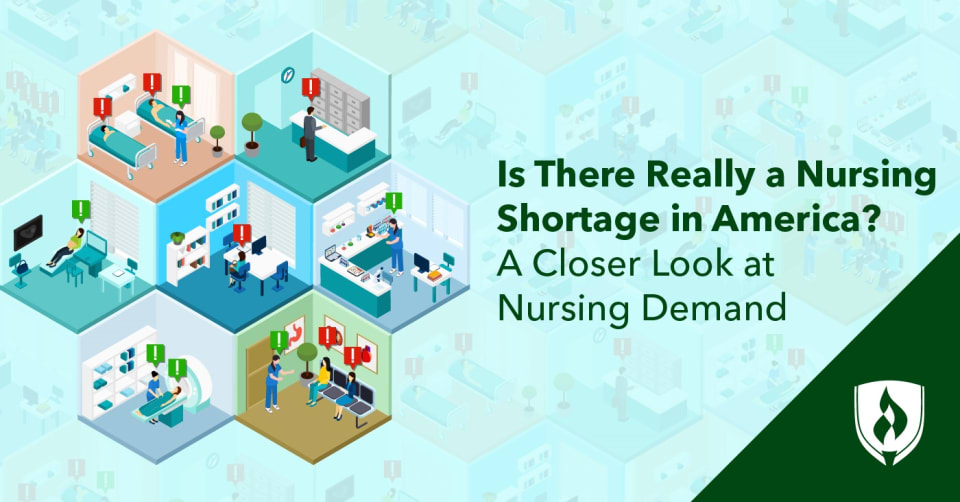Is There Really a Nursing Shortage in America? A Closer Look at Nursing Demand
By Kristina Ericksen on 08/23/2016

If you’ve spent any time researching healthcare career options, there’s a good chance you’ve heard about a potential nursing shortage in America. The American Nurses Association projects that by 2022, there will be more registered nurse (RN) jobs available than any other profession, and the Bureau of Labor Statistics has projected the need for 1.1 million new registered nurses to avoid the shortage.
And there’s more to consider than just the net-new nursing jobs. Every year, scores of baby boomer nurses retire, and new nurses are needed to replace them—and that doesn’t even account for those leaving the healthcare field after burning out in the wake of the COVID-19 pandemic.
These figures factor into one of the biggest stories in healthcare: a nationwide nursing shortage in the United States. So what does that mean for you?
Join us as we analyze the facts surrounding the longstanding demand for additional qualified nurses in the U.S. and learn more about the role you could play as we begin taking steps to strengthen and replenish our nursing workforce.
What’s causing the nursing shortage?
An aging population
One large driver of the nursing shortage is the aging population in America. In 2018, the U.S. was home to an estimated 52 million people age 65 or older, according to the Population Reference Bureau (PRB).2 That number is expected to rise in the near term, as well, as the last of the baby boom generation reaches age 65 by 2030.
With the advancement of medical technology allowing elderly patients to live longer than ever, this means that aging baby boomers may require care for long-term conditions for years on end, putting more strain on the healthcare system. The PRB estimates that the baby boomers will cause a 75 percent increase in Americans age 65 and older who require nursing home care.3
Retiring nurses
Get ready to pass the sheet cake slices—retirements are coming. The previously mentioned group of aging Americans includes hundreds of thousands of practicing RNs on the verge of retirement who will need replacing—and who will soon be moving into an age bracket that makes them more likely to be patients themselves.
The American Nurses Association expects more than 500,000 experienced nurses will retire by 2022—and that doesn’t even include those who may have retired early or left the field in the midst of the COVID-19 pandemic.1 No matter the exact figure, demographic trends are pointing to a large, seasoned portion of the overall nursing workforce heading for the exits.
A lack of nursing education options
Retiring RNs don’t just affect the patient care side of nursing. According to an American Association of Colleges of Nursing (AACN) report on 2019–20 Enrollment and Graduations in Baccalaureate and Graduate Programs in Nursing, schools in the U.S. turned away 80,407 qualified nursing applicants due to insufficient faculty, clinical sites, classroom space and funding.4
It takes a nurse to train a nurse, and this glut of retirements doesn’t spare the critical nurse educators who are bringing the next generation of nurses up to speed.
The COVID-19 pandemic
It’s likely too early to get a clear picture of the long-term impact COVID-19 has had on employment in the nursing field, there are certainly indications it hasn’t helped. Nurses are reeling from the burden of caregiving during the pandemic, with one workforce survey conducted during the early months of the pandemic finding that 67 percent of nurses were considering leaving their professions as a result of COVID-19.5 While the timing of this survey likely captured the feelings of nurses during one of the peak periods of uncertainty, it’s reasonable to assume at least some of these nurses may have decided to follow through with walking away from the field.
Effects of the nursing shortage
Increased nurse-to-patient ratios
An obvious impact of the nursing shortage is the heightened nurse-to-patient ratios that inevitably take place when a unit is short-staffed. This can have adverse effects on the quality of a nurse’s professional life, often leading to nursing burnout.
Even non-nurses can feel the residual effects of nurse burnout. While there’s a lot of variables that can influence outcomes, studies suggest a higher nurse-to-patient ratio helps protect patients from poor outcomes.4
While many nurses are incredibly efficient in their duties, too large of a patient load can lead to mistakes or insufficient time to fully address patient questions or concerns—and that can hurt the overall effectiveness of a healthcare visit.
Financial cost
There’s also a monetary cost associated with nursing shortages. Some estimates put the cost of high nursing turnover between $88 billion and $137 billion just as a result of the COVID-19 pandemic.5
It’s a basic case of supply and demand as understaffed hospitals find themselves offering higher salaries, bonuses and signing packages to lure qualified nurses to their facilities.6 Rural hospitals, which tend to be particularly hard hit by nursing shortages, often don’t have the funds to offer salaries comparable to their urban counterparts.
Nursing shortage solutions
Educating the next generation of nurses
Many agree that addressing the imminent nursing shortage in the U.S. must begin with enabling the thousands of aspiring nurses to begin their careers—which will only be possible with more educators in nursing programs to cope with the demand. With this in mind, several state level initiatives have been put into motion to offer incentives, like fellowships and loan forgiveness, for future nurse faculty who commit to teach within that state after obtaining their degrees.
Improving the work environment
Resolving the nursing shortage will continue to face headwinds if nurses experience overwhelming levels of stress, burnout and professional dissatisfaction. Changing the work environment for nurses could improve worker retention and put a plug in the flow of nurses leaving the field.
The American Hospital Association is calling for healthcare facilities to implement programs and policies designed to protect the mental health of nurses and other staff. This includes facilitating an environment that allows for open dialogue between colleagues, a Code Lavender protocol that allows team members to recognize when a peer needs to be removed from an overwhelming situation, and additional training to help nurses and healthcare leaders cope with stress.7
Could you help fill the gap in nursing?
You can see how the nursing shortage in the United States has led to high demand for nurses across the nation. Is there still a nursing shortage, you might wonder? While some of the figures and challenges presented by this shortage may seem daunting, there’s a silver lining to be found: America clearly needs qualified nurses.
If a nursing career is on your radar, you could potentially play an important role in helping to fill the gap in nursing. Our article “How to Become an RN Fast: 3 Potential Paths to Pursue” can help you map out your best path toward becoming an RN.
1“Workforce” American Nurses Association [accessed April 2021] https://www.nursingworld.org/practice-policy/workforce/
2Christine Himes and Lillian Kilduff, “Which U.S. States Have The Oldest Populations?” Population Reference Bureau. March 16, 2019 [accessed April 2021] https://www.prb.org/resources/which-us-states-are-the-oldest/
3Mark Mather, Linda Jacobson and Kelvin Pollard, “Population Bulletin: Aging Baby Boomers to Face Caregiving, Obesity, Inequality Challenges” Population Reference Bureau. January 13, 2016 [accessed April 2021] https://www.prb.org/unitedstates-population-bulletin/
4Mary Blegen, Colleen Goode, Joanne Spetz, Thomas Vaughn and Shin Hye Park, “Nurse Staffing Effects on Patient Outcomes: Safety-Net and Non-Safety-Net Hospitals” Medical Care 49, no. 4 (2011) [accessed April 2021] https://www.jstor.org/stable/41103933?seq=1
5Gert Volmer, “Nurse Burnout In the Wake of COVID-19 Can Cost Up to $137B” HOLLIBLU and Feedtrail April 13, 2020 [accessed April 2021] https://www.feedtrail.com/nurse-burnout-in-the-wake-of-covid-19-can-cost-up-to-137b/
6Ilene MacDonald “The Financial Impact of the Nationwide Nursing Shortage: Hospitals Pay Billions to Recruit and Retain Nurses” Fierce Healthcare October 23, 2017 [accessed April 2021] https://www.fiercehealthcare.com/finance/financial-impact-nationwide-nursing-shortage-hospitals-pay-billions-to-recruit-and-retain
7Anne Schmidt, “We Need to Talk About Burnout the Same Way We Talk About Benefits” American Hospital Association. October 20, 2020 [accessed April 2021] https://www.aha.org/news/blog/2020-10-20-we-need-talk-about-burnout-same-way-we-talk-about-benefits




